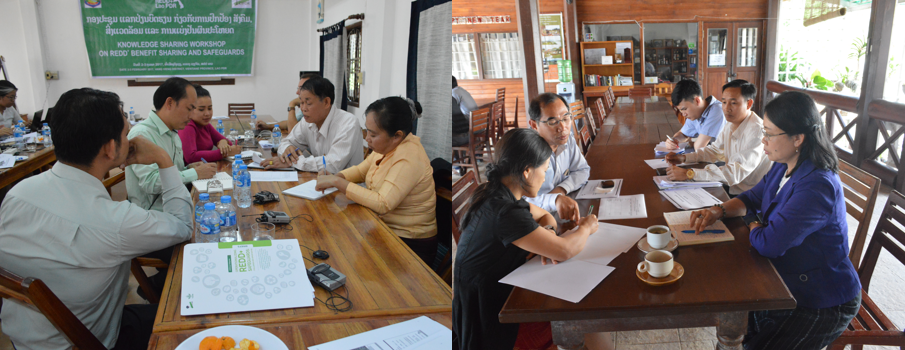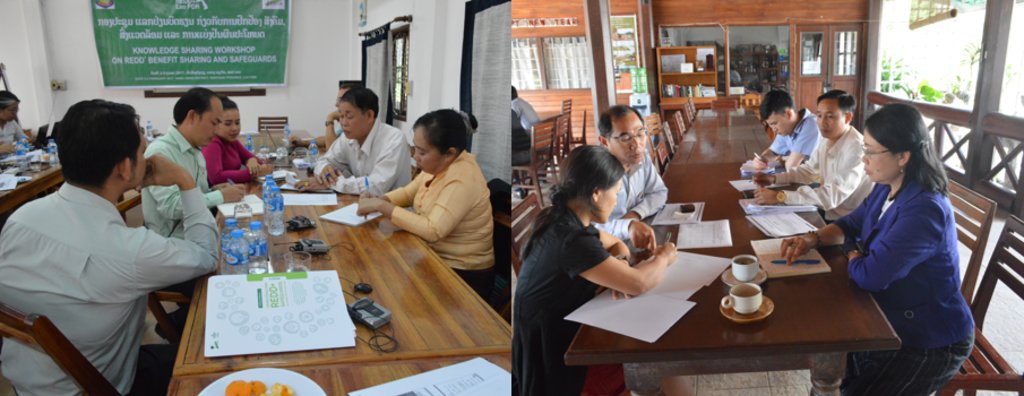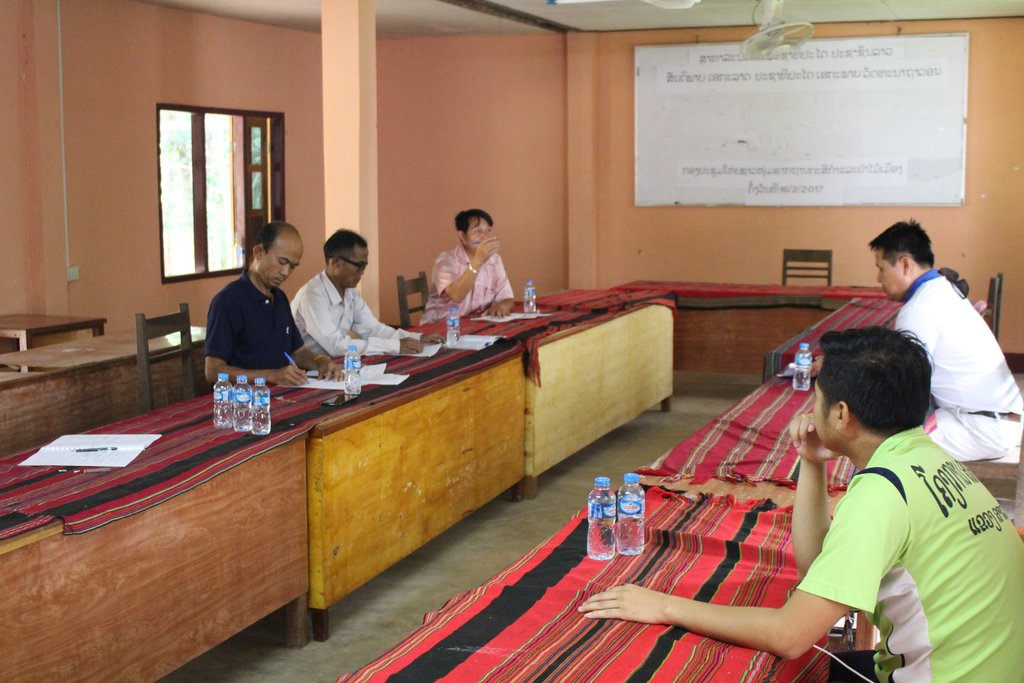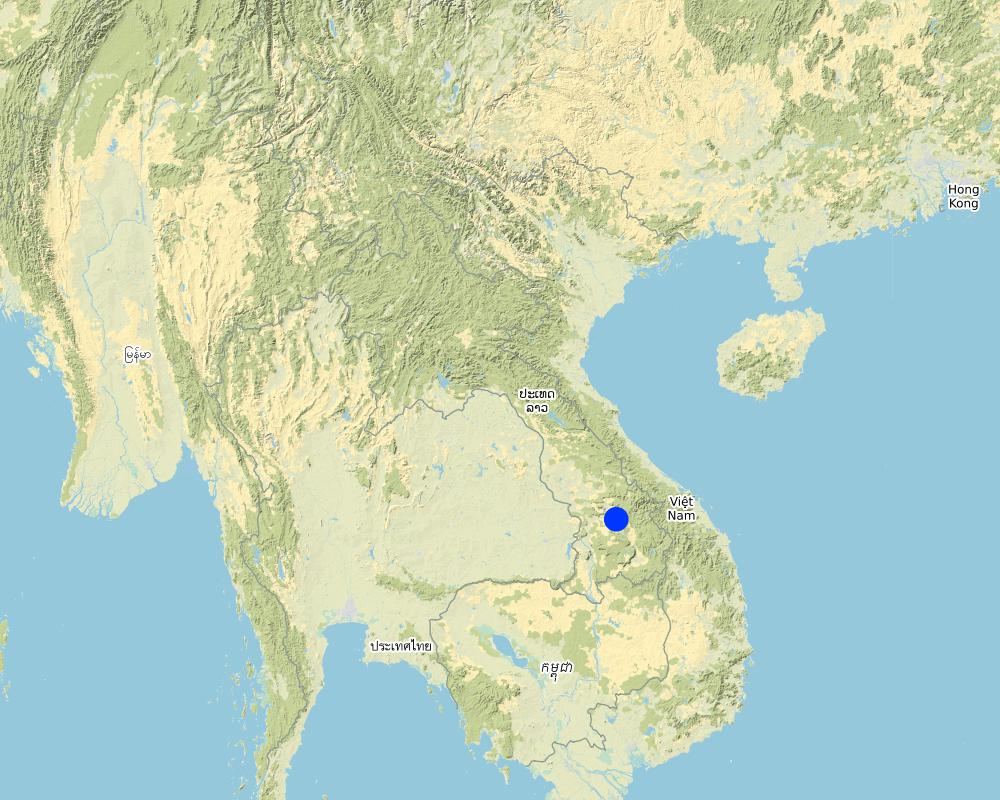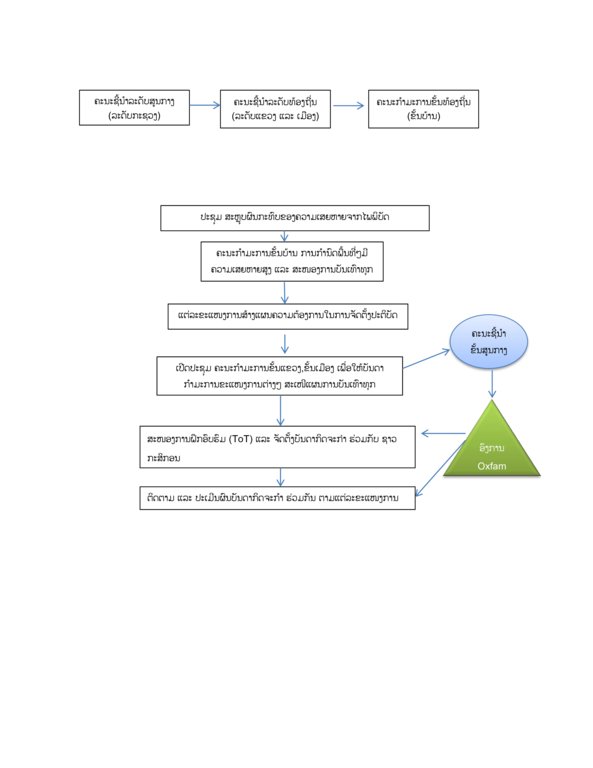The Upland Community Disaster Risk Reduction Project [جمهورية لاو الديمقراطية الشعبية]
- تاريخ الإنشاء:
- تحديث:
- جامع المعلومات: Pasalath Khounsy
- المحرر: Bounthanom Bouahom
- المراجعون: Nicole Harari, William Critchley
approaches_3218 - جمهورية لاو الديمقراطية الشعبية
عرض الأقسام
توسيع الكل طي الكل1. معلومات عامة
1.2 تفاصيل الاتصال بالأشخاص الرئيسيين لمصدر المعلومات والمؤسسات المعنية بتقييم وتوثيق النهج
الشخص (الأشخاص) الرئيسي لمصدر المعلومات
مستخدم الأرض:
Malichanse Soukkaseum
smalychansy@gmail.com
Oxfam Australia in Saravan province
جمهورية لاو الديمقراطية الشعبية
District steering committee:
Vilaysak Seuth
Taouy District of Agriculture and Forestry Office
جمهورية لاو الديمقراطية الشعبية
District steering committee:
Keokhamma Boutsa
ໍ+8562099704868
TaOuy District Labour and Social Welfare Office
جمهورية لاو الديمقراطية الشعبية
اسم المشروع الذي سهّل توثيق/تقييم النهج (إذا كان ذلك على صلة)
Scaling-up SLM practices by smallholder farmers (IFAD)اسم المؤسسة (المؤسسات) التي سهلت توثيق/تقييم النهج (إذا كان ذلك على صلة)
National Agriculture and Forestry Research Institute (NAFRI) - جمهورية لاو الديمقراطية الشعبية1.3 الشروط المتعلقة باستخدام البيانات الموثقة من خلال WOCAT
متى تم تجميع البيانات (ميدانيا)؟:
31/08/2017
يوافق جامع المعلومات والشخص (لاشخاص) الرئيسي لمصدر المعلومات على الشروط المتعلقة باستخدام البيانات الموثقة من خلال WOCAT:
نعم
2. وصف نهج الإدارة المستدامة للأراضي
2.1 وصف موجز للنهج
The disaster risk reduction project in upland communities aims to increase understanding about disaster management, disaster risk reduction, and community resilience. The main activities include emergency response during floods/droughts, reduction of impacts from disease outbreaks, livestock revolving funds, and village rice banks.
2.2 وصف تفصيلي للنهج
وصف تفصيلي للنهج:
The disaster risk reduction project in upland communities was established after the Ketsana typhoon hit the southern region of Lao PDR in 2008, causing significant losses to assets, infrastructure, and agricultural land. The project was approved by the Ministry of Labour and Social Welfare, and Ministry of Planning and Investment to be implemented at community level through a project steering committee which included the deputy provincial governor. The district governor was the project director at the local level based on an action plan developed by the ministries concerned with assistance from Oxfam Australia. This action plan was aimed at disaster prevention and control. The project coordinators came from the relevant government agencies including the District Labour and Social Welfare Office, the District Agriculture and Forestry Office, the District Administration Office, the District Health Office, the District of Natural Resources and Environment Office, and mass organizations (Women’s Union, Youth Union, Trades Union, and Lao Front for National Construction). The key project aims are to increase understanding about disaster management, disaster risk reduction, and community resilience. The main activities to be implemented include emergency response during floods/droughts, reduction of impacts from disease outbreaks, livestock revolving funds, and village rice banks. In the agriculture sector, the project promotes integrated crop cultivation (maize, beans, lemons, etc), a particular rice planting method termed SRI (System of Rice Intensification), and household gardens. In addition, Oxfam Australia and the local government of Lao PDR in cooperation with Care International (Xekong Province), and the World Food Programme provided emergency response and relief, and sanitation. Although there are a number of organizations which have contributed to disaster risk reduction and emergency response, constraints remain such as the implementation of limited life projects, inadequate funding, and a lack of coordination in the province and districts.. Village Committees for Disaster Prevention and Control have been established with regular meetings and disaster awareness campaign activities implemented. The project outcomes demonstrated that the communities are satisfied with their active participation.
2.3 صور عن النهج
2.5 البلد/المنطقة/المواقع التي تم تطبيق النهج فيها
البلد:
جمهورية لاو الديمقراطية الشعبية
المنطقة/الولاية/المحافظة:
Saravan province
مزيد من التفاصيل حول الموقع:
Taouy district
Map
×2.6 تواريخ بدء وإنهاء تنفيذ النهج
أشر إلى سنة البدء:
2008
في حالة عدم معرفة السنة بالتحديد، يرجى الإشارة إلى التاريخ التقريبي لبدء النهج:
منذ أقل من 10 سنوات (مؤخرًا)
سنة الإنهاء (إذا لم يعد النهج مطبقًا):
2014
التعليقات:
There have been two different phase of project implementation. The first phase was from 1999-2001 and the second phase was 2008-2014.
2.7 نوع النهج
- قائم على مشروع/برنامج
2.8 الغايات/الأهداف الرئيسية للنهج
The objectives of the project are to increase understanding about disaster management, disaster risk reduction, and community development in disaster impacted areas.
2.9 الظروف التي تمكن أو تعيق تنفيذ التقنية/التقنيات المطبقة بموجب النهج
المعايير والقيم الاجتماعية /الثقافية/ الدينية
- تمكين/تمكيني
Gender aspect – the project changed immoral traditional and cultural beliefs of people by encouraging men to have more involvement in household activities with women.
- معيق
The two different farmer’s groups in the village do not want to work together - including on establishment of village rice banks and water borehole drilling.
توفر/الوصول إلى الموارد والخدمات المالية
- تمكين/تمكيني
Provide greater opportunities to vulnerable households to participate in the project, encourage local communities to access finance and animals for their own operations.
الإطار المؤسساتي
- تمكين/تمكيني
Established the district and village committees levels in order to support the construction and administration work.
التعاون/التنسيق بين الجهات الفاعلة
- تمكين/تمكيني
Regular collaboration with various levels including provincial, district and village.
الإطار القانوني (حيازة الأراضي، وحقوق استخدام الأراضي والمياه)
- تمكين/تمكيني
السياسات
- تمكين/تمكيني
حوكمة الأراضي (صنع القرار والتنفيذ والإنفاذ)
- تمكين/تمكيني
المعرفة حول الإدارة المستدامة للأراضي، والوصول إلى الدعم الفني
- تمكين/تمكيني
الأسواق (لشراء المدخلات وبيع المنتجات) والأسعار
- تمكين/تمكيني
Set up the Chinese pear selling group
عبء العمل، توفر القوى العاملة
- تمكين/تمكيني
3. المشاركة وأدوار الأطراف المعنية
3.1 أصحاب المصلحة المعنيون بالنهج وأدوارهم
- مستخدمو الأراضي المحليون/المجتمعات المحلية
Farmer’s group
Implementer
- المنظمات المجتمعية
Village authorities and village organisation
Approve, certify and dissemination of key information
- متخصصون في الإدارة المستدامة للأراضي / مستشارون زراعيون
District Agriculture and Forestry Office staffs
Supervise the project implementation and provide training
- منظمة غير حكومية
Oxfam Project Staffs
Supervise the project implementation and provide training
- الحكومة المحلية
Provincial Agriculture and Forestry Office and District of Agriculture and Forestry Office staffs
Leading, monitoring the implementation of the project and provide training
- الحكومة الوطنية (المخططون، صانعو القرار)
Central Administrative Office in Vientiane and Ministries level.
Consultaition and approve the project implementation at national level.
- منظمة دولية
Oxfam International Office
Financial support
3.2 انخراط مستخدمي الأراضي المحليين/المجتمعات المحلية في المراحل المختلفة للنهج
| انخراط مستخدمي الأراضي المحليين/المجتمعات المحلية | حدد من شارك وصف الأنشطة | |
|---|---|---|
| المبادرة/التحفيز | تفاعلي | |
| التخطيط | تفاعلي | |
| التنفيذ | تفاعلي | |
| الرصد/التقييم | تفاعلي | |
| Field exchange | تفاعلي | Facilitate 20 staff and training on disaster management and 7 farmers from each village conducted the field exchange on rice production technologies. |
3.3 مخطط التدفق (إذا كان متاحًا)
3.4 اتخاذ القرار بشأن اختيار تقنية/تقنيات الإدارة المستدامة للأراضي
حدد من الذي قرر اختيار التقنية/التقنيات التي سيتم تنفيذها:
- جميع الجهات الفاعلة ذات الصلة، كجزء من نهج تشاركي
حدد على أي أساس تم اتخاذ القرارات:
- تقييم المعرفة الموثقة جيدًا بشأن الإدارة المستدامة للأراضي(اتخاذ القرارات القائمة على الأدلة)
- خبرة وآراء شخصية(غير موثقة)
4. الدعم الفني وبناء القدرات وإدارة المعرفة
4.1 بناء القدرات/التدريب
هل تم تقديم التدريب لمستخدمي الأراضي / الأطراف المعنيين الآخرين؟:
نعم
حدد من تم تدريبه:
- مستخدمو الأراضي
- موظفون ميدانيون/ مستشارون
شكل التدريب:
- في العمل
- من مزارع إلى مزارع
المواضيع المغطاة:
The fund management, water supply uses, rice bank, veterinary, chicken raising, aquaculture, rice production, disaster risk preparedness and response, typhoon, forest fires, disaster warning equipment.
4.2 خدمة استشارية
هل يملك مستخدمو الأراضي وصولا إلى خدمة استشارية؟:
نعم
حدد ما إذا كانت الخدمة الاستشارية متوفرة:
- في حقول مستخدمي الأراضي
وصف/تعليقات:
Once per month
4.3 تعزيز المؤسسات (التطوير التنظيمي)
هل تم إنشاء أو تعزيز مؤسسات من خلال هذا النهج؟:
- نعم، باعتدال
حدد المستوى (المستويات) التي تم فيها تعزيز أو إنشاء المؤسسات:
- محلي
صف المؤسسة والأدوار والمسؤوليات والأعضاء وما إلى ذلك.
The district and village committees for disaster prevention and control are responsible for supervising, acting as focal points and reporting to the provincial and central levels.
حدد نوع الدعم:
- مالي
- بناء القدرات/التدريب
- معدات
4.4 الرصد والتقييم
هل يشكل الرصد والتقييم جزءا من النهج؟:
نعم
التعليقات:
The M&E team of the Oxfam project organized a monthly monitoring meeting involving collaboration with the community board at village and district levels.
إذا كانت الإجابة بنعم، فهل من المقصود استخدام هذه الوثائق للمراقبة والتقييم؟:
نعم
4.5 البحوث
هل كانت البحوث جزءًا من النهج؟:
نعم
حدد المواضيع:
- تكنولوجيا
أعط تفاصيل إضافية وأشر إلى من قام بالبحوث:
A number of potentially appropriate activities have been modified to fit local conditions, such as: promotion economics / marketing of animal breeds that people never raised before.
5. التمويل والدعم المادي الخارجي
5.1 الميزانية السنوية لمكون الإدارة المستدامة للأراضي في النهج المذكور
أشر إلى ميزانية النهج السنوية لمكون الإدارة المستدامة للأراضي بالدولار الأمريكي:
100000,00
إذا لم تكن الميزانية السنوية الدقيقة معروفة، قم بالإشارة إلى نطاقها:
- 100,000-10,000
التعليقات (على سبيل المثال المصادر الرئيسية للتمويل/الجهات المانحة الرئيسية):
AUSAid funding source
5.2 الدعم المالي/المادي المقدم لمستخدمي الأراضي
هل حصل مستخدمو الأراضي على دعم مالي/ مادي لتنفيذ التقنية/ التقنيات؟:
نعم
إذا كانت الإجابة بنعم، حدد نوع (أنواع) الدعم والشروط والمزودين:
Financial supported by AUSAid and implemented by Oxfam Australia
5.3 إعانات لمدخلات محددة (بما في ذلك العمالة)
- عمالة
| إلى أي مدى | حدد الإعانات |
|---|---|
| ممول بالكامل | local communities supplied labor and the project paid for this |
- بناء
| حدد المدخلات التي تم دعمها | إلى أي مدى | حدد الإعانات |
|---|---|---|
| حجر | ممول بالكامل | |
| خشب | ممول جزئيا | Villagers |
- بنى تحتية
| حدد المدخلات التي تم دعمها | إلى أي مدى | حدد الإعانات |
|---|---|---|
| طرق | ممول بالكامل | Project |
| مدارس | ممول بالكامل | Project |
إذا كان العمل من قبل مستخدمي الأراضي مدخلاً جوهريًا، فهل كان:
- الغذاء مقابل العمل
5.4 الائتمان
هل تم توفير ائتمان في إطار نهج أنشطة الإدارة المستدامة للأراضي؟:
كلا
5.5 حوافز أو وسائل أخرى
هل تم استخدام حوافز أو أدوات أخرى لتشجيع تنفيذ تقنيات الإدارة المستدامة للأراضي؟:
كلا
6. تحليل الأثر والتصريحات الختامية
6.1 آثار النهج
هل ساهم النهج في تمكين مستخدمي الأراضي المحليين وتحسين مشاركة الأطراف المعنية؟:
- لا
- نعم، قليلا
- نعم، باعتدال
- نعم، إلى حد كبير
هل مكّن النهج من اتخاذ القرارات المبنية على الأدلة؟:
- لا
- نعم، قليلا
- نعم، باعتدال
- نعم، إلى حد كبير
هل ساعد النهج مستخدمي الأراضي على تنفيذ وصيانة تقنيات الإدارة المستدامة للأراضي؟:
- لا
- نعم، قليلا
- نعم، باعتدال
- نعم، إلى حد كبير
هل نجح النهج في تحسين التنسيق والتنفيذ الفعال من حيث التكلفة لأنشطة الإدارة المستدامة للأراضي؟:
- لا
- نعم، قليلا
- نعم، باعتدال
- نعم، إلى حد كبير
هل نجح النهج في تعبئة/تحسين الوصول إلى الموارد المالية لتنفيذ الإدارة المستدامة للأراضي؟:
- لا
- نعم، قليلا
- نعم، باعتدال
- نعم، إلى حد كبير
هل أدى النهج إلى تحسين معرفة وقدرات مستخدمي الأراضي على تنفيذ الإدارة المستدامة للأراضي؟:
- لا
- نعم، قليلا
- نعم، باعتدال
- نعم، إلى حد كبير
هل أدى النهج إلى تحسين معرفة وقدرات الأطراف المعنية الأخرى؟:
- لا
- نعم، قليلا
- نعم، باعتدال
- نعم، إلى حد كبير
هل ساهم النهج في بناء/تعزيز المؤسسات والتعاون بين الأطراف المعنية؟:
- لا
- نعم، قليلا
- نعم، باعتدال
- نعم، إلى حد كبير
هل ساهم النهج في التخفيف من حدة الصراعات؟:
- لا
- نعم، قليلا
- نعم، باعتدال
- نعم، إلى حد كبير
هل ساهم النهج في تمكين الفئات المحرومة اجتماعيا واقتصاديا؟:
- لا
- نعم، قليلا
- نعم، باعتدال
- نعم، إلى حد كبير
هل أدى النهج إلى تحسين المساواة بين الجنسين وتمكين النساء والفتيات؟:
- لا
- نعم، قليلا
- نعم، باعتدال
- نعم، إلى حد كبير
هل شجع النهج الشباب/الجيل القادم من مستخدمي الأراضي على الانخراط في الإدارة المستدامة للأراضي؟:
- لا
- نعم، قليلا
- نعم، باعتدال
- نعم، إلى حد كبير
هل أدى هذا النهج إلى تحسين الأمن الغذائي / تحسين التغذية؟:
- لا
- نعم، قليلا
- نعم، باعتدال
- نعم، إلى حد كبير
هل أدى النهج إلى تحسين الوصول إلى الأسواق؟:
- لا
- نعم، قليلا
- نعم، باعتدال
- نعم، إلى حد كبير
هل أدى النهج إلى تحسين الوصول إلى المياه والصرف الصحي؟:
- لا
- نعم، قليلا
- نعم، باعتدال
- نعم، إلى حد كبير
هل أدى النهج إلى تحسين قدرة مستخدمي الأراضي على التكيف مع التغيرات المناخية/الظواهر المناخية المتطرفة والتخفيف من الكوارث المرتبطة بالمناخ؟:
- لا
- نعم، قليلا
- نعم، باعتدال
- نعم، إلى حد كبير
The end of project, there is no follow up activity but some activity were went well especially for the rice bank.
هل أدى النهج إلى توفير فرص عمل ودخل؟:
- لا
- نعم، قليلا
- نعم، باعتدال
- نعم، إلى حد كبير
Some people have learned from the project and gained useful knowledge and experiences which has enabled them to find other employment opportunities.
6.2 المحفز الرئيسي لقيام مستخدمي الأراضي بتنفيذ الإدارة المستدامة للأراضي
- زيادة الإنتاج
- زيادة الربح (القدرة)، وتحسين نسبة التكلفة إلى العائد
- الحد من مخاطر الكوارث
- انخفاض عبء العمل
- القواعد واللوائح (الغرامات) / الإنفاذ
- الانتماء إلى حركة/ مشروع/ مجموعة/ شبكات
- الوعي البيئي
- العادات والمعتقدات والأخلاق
- تعزيز المعرفة والمهارات في مجال الإدارة المستدامة للأراضي
6.3 استدامة أنشطة النهج
هل يمكن لمستخدمي الأراضي المحافظة على استدامة ما تم تنفيذه من خلال النهج (بدون دعم خارجي)؟:
- نعم
إذا كانت الإجابة بنعم، صف كيف:
The rice production and animal breeding groups are able to maintain their initiatives. Gravity fed water supply system, school, road have been supported by other development organizations.
6.4 نقاط قوة/مزايا النهج
| نقاط القوة/ المزايا/ الفرص من وجهة نظر مستخدمي الأراضي |
|---|
| Project implementation plan is parallel with the district development strategy and meets the needs of local people. |
| Build understanding on project management, project coordination in each level. |
| Continuous project monitoring for approximately 3 – 5 years. |
| Mobilization for participation in activities. |
| نقاط القوة/ المزايا/ الفرص من وجهة نظر جامع المعلومات أو غيره من الاشخاص الرئيسيين لمصدر المعلومات |
|---|
| The project apply the participatory approach from early stage until monitoring phase. |
| Promotion of all concerned agencies and offices. |
| Detailed assessment for capacity building in planning for equipment/material supply, vehicles, staff visit the villages regularly. |
6.5 نقاط الضعف/ العيوب في المنهج وطرق التغلب عليها
| نقاط الضعف/ المساوىء/ المخاطر من وجهة نظر مستخدم الأراضي | كيف يمكن التغلب عليها؟ |
|---|---|
| The staff lack appropriate knowledge and skills | Provide more training on technical knowledges and skills and other relevant topics. |
| There is still a large gap to understanding on certain topics between officials and local communities. | On-the-job training, use video as a means for communication to increase local people’s understanding. |
| Dependency on project and government to implement activities. | |
| Some immoral traditional and cultural beliefs are still hindering development efforts. | It is recommended to increase awareness of village elders who can then influence the local people. |
| نقاط الضعف/ المساوىء/ المخاطر من وجهة نظر جامع المعلومات أو غيره من الاشخاص الرئيسيين لمصدر المعلومات | كيف يمكن التغلب عليها؟ |
|---|---|
| Lack of financial resources to monitor project activities. | |
| There were issues with repayment to village development fund, animal revolving fund in order to rotate to other households. | The need to have a robust contract and revise regulations. |
| Delayed supply of materials which is impact to late activity implementation. | |
| Hand over of responsibilities to persons with insufficient capability. | Consider to transfer the activity to local implementers. |
7. المراجع والروابط
7.1 طرق جمع/مصادر المعلومات
- زيارات ميدانية، مسوحات ميدانية
1 time
- مقابلات مع مستخدمي الأراضي
2 land users
- مقابلات مع المتخصصين/الخبراء في الإدارة المستدامة للأراضي
1SLM expertise
الروابط والوحدات المواضيعية
توسيع الكل طي الكلالروابط
لا يوجد روابط
الوحدات المواضيعية
لا يوجد وحدات مواضيعية


